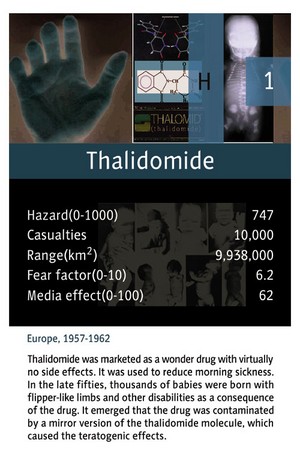|

Thalidomide first appeared in Germany on 1 October 1957. Considered a mild sedative with few side effects it was prescribed for thousands of pregnant women worldwide as a remedy against morning sickness. Thalidomide was marketed in 46 countries as a �wonder drug� that provided a �safe, sound sleep�.
By the end of the fifties a remarkably high number of babies were born with shocking disabilities. It turned out than when taken during pregnancy, thalidomide would either kill the foetus or cause severe disabilities, including brain damage, blindness, deafness, disfigurement, cleft palate and internal disabilities.
The most famous disability is the Pharcomelia, where the child has flipper-like arm limbs. It is estimated that more than 12,000 babies were crippled by thalidomide. Most of the effects were purely physical and the affected babies were able to live relatively normal lives.
There is, however, evidence that Thalidomide has changed the DNA of the victims. The rate of passing on disabilities to the next generation is 5 times higher than in the rest of the population.
Much later it was shown that thalidomide exists in two different versions, where the second is the mirror version of the first. These two so-called stereoisomers named (+)-(R)-thalidomide and (-)-(S)-thalidomide respectively, have the same chemical formula and connectivity but differ in the position of the atoms in space. The R-version has the desired sedative effects whereby the S-version has the teratogenic effects.
However, the tragedy in the 60s could not have been avoided with the use of the (R)-version only, because there is a spontaneous, partial conversion from the R-version to the S-version within 8-10 hours after oral intake.
Thalidomide was taken off the market in the early sixties. In the mid-sixties it was rediscovered as a remedy for inflammatory diseases. Thalidomide is now being investigated as a possible remedy for cancer and AIDS patients.
Comment this page
 
Links and references:
The Importance of Chirality:
http://www.uyseg.org/catalysis/asymmetric/asymm1.h...
An example of a recent capsule description including side effects:
http://www.celgene.com/images/pdf/$FILE/Thalomid_P...
Canadian association of victims:
http://www.thalidomide.ca/
Overview:
http://www.chm.bris.ac.uk/motm/thalidomide/first.h...
|

|
|



